Modern marketers have access to dozens of tools and variety of mediums for their content. On one hand, it provides almost infinite possibilities. On the other hand, it often ends in a mess.
One way to organize your marketing activities is to make use of a sales funnel. In this article, we will consider the features of different sales funnel stages and figure out which tools are most suitable for each of them.
What is a sales funnel?
The sales funnel is a sequence of stages that a customer goes through from their first contact with a company to making a purchase. It may start with the customer reading a product description on a website, continue with them downloading a trial, and lead to the customer buying the full version.
With each step, loyalty to the company and the chance of a user making a purchase grows. But, as the funnel analogy shows, not everyone who enters the process will become a customer. At each sales funnel stage, some users drop off for various reasons — the funnel narrows.
Why do you need a sales funnel?
Increasing the effectiveness of the sales funnel is considered the second most important sales objective. As you can see, the sales funnel is a pretty big deal.
An efficient sales funnel will help you to:
- Catch up with potential customers. People do not make a purchase right away; they browse, going through many options and often forget what they have seen. From this perspective, a sales funnel serves to quickly move visitors closer to making a purchase.
- Profit from inbound contacts. Inbound tactics cost less than outbound tactics, and in the opinion of 53% of marketers, deliver higher performance. Put simply, this means that initiating a new contact is more expensive and less efficient than maintaining communication with customers who already showed some interest in your product. Using a sales funnel helps you go beyond just acquiring people to contact by helping you nurture inbound contacts into customers.
- Match expectations. Users’ expectations change a lot from the moment they realize their need to whent they decide to buy a solution. Only by building a step-by-step funnel, can a company consider all of these transformations and be ready to meet customers’ expectations.
All together, this suggests that the sales funnel provides a clear framework for all marketing activities like matching specific tools, touchpoints, and KPIs to each of its stages.
What are the sales funnel stages?
The classic sales funnel involves four steps:
- Awareness
- Interest
- Desire
- Action
Naturally, the Awareness stage begins when total strangers see your website in their search results. Then they may visit your website, which moves them into the Interest stage. If visitors join your mailing list, congratulations, they have entered the Desire stage. Any subsequent purchase of a product or service represents the Action stage.
However, customer relationships don’t end with a purchase. A wise business makes every effort so the buyer returns for repeat purchases, while also attracting new customers. Consequently, an important fifth step must also be considered:
- Satisfaction
With the added Satisfaction stage, this sales funnel model is abbreviated to AIDAS. It represents an approach to help you adapt your marketing efforts according to the specifics of a particular sales funnel stage. The marketing medium and tools you use will differ for a total newcomer and the lead. Let’s see what should be done from A to S to move a prospect from one stage to the next.
Sales Funnel Stage 1: Awareness
User role: stranger
Goal: attract the user to your website
Medium: search engines, social media, specialized websites, and blogs
Tools: SEO (search engine optimization), PPC (pay per click ads), social media advertising, display advertising
At this sales funnel stage, you have a very wide audience, but they are the least prepared to make a purchase. It is necessary to understand what customers are looking for and to ensure the company has a presence where they can find it. You can expect your audience to use search engines and social media, so it’s a good idea you are visible there.
With your SEO strategy, you need to do the following:
- Determine relevant keywords
- Optimize your website for these keywords
- Set up advertising to be displayed when a user searches for them
As for your SMM strategy, everything starts with your audience:
- Define your target audience
- Select networks most popular with them
- Set up advertising directed at your target audience on relevant networks
If the name of your company is unfamiliar to your audience, consider setting up non-branded advertising. For example, to compete with manufacturers, eCommerce websites, such as Amazon, use non-branded ads triggered by key product features rather than by a brand name.
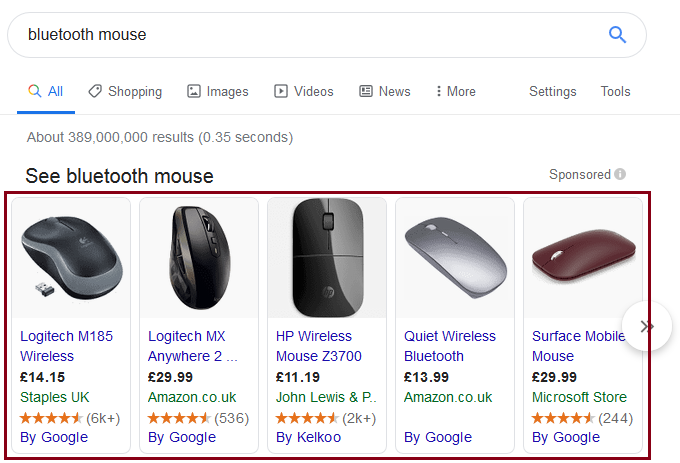 Amazon and Best Buy non-branded ads triggered by the keyword “bluetooth”
Amazon and Best Buy non-branded ads triggered by the keyword “bluetooth”
Conversely, if you type in the name of a manufacturer, you’ll see branded ads.
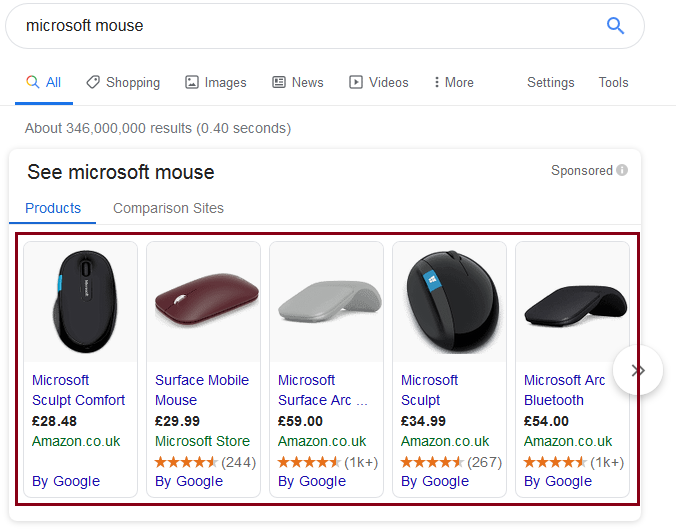 Branded ad triggered by Microsoft brand name
Branded ad triggered by Microsoft brand name
Sales Funnel Stage 2: Interest
User role: visitor
Goal: encourage interaction with your content
Medium: website, social media pages
Tools: content marketing, lead generation forms, remarketing
Good job, there are new visitors on your website or social page. Now the main question is whether they have a great experience and want to come back.
During the Interest stage, a company needs to establish trust by introducing itself. It may be too early for a sales proposal, but it is high time to answer common questions. Here, educational content is very useful: case studies, videos and podcasts, posts, and articles.
IoT (Internet of Things) page with expert articles, relative surveys, and white papers by TE Connectivity
Perhaps you are very lucky and first-time visitors make purchases on your website. But we, mere mortals, should do our best to motivate newbies to return. That is why it is also essential to offer valuable information in exchange for an email address — aka a lead magnet.
Next, remember that the buyer’s journey is not always linear: advertising — website — purchase. Visitors may leave your website and forget about it. Then, maybe the next day, they see your ad on Instagram and follow your account. So they may read your posts for some time, becoming more and more engaged. Lastly, they may click through to your website, subscribe to your mailing list to receive several promotional emails and finally make a purchase! All these are possible if you use a remarketing campaign, advertising shown to users who have interacted with your website already.
There are two basic remarketing algorithms:
- Pixel-based. In this case, you install a so-called pixel on your website to track relevant visitors based on the pages they visit or the actions they perform.
- List-based. This method requires you to upload a list of email addresses to the advertising platform. The latter will match the list with the existing users.
Sales Funnel Stage 3: Desire
User role: lead
Goals: initiate a purchase
Medium: email, website, search engines, social media, review websites, specialized websites, and blogs
Tools: promo and trigger emails, branded ads, content marketing, remarketing, events
Warmer prospects may start comparing your product to others, searching for the best. That is why, at the Desire stage, you need to monitor review websites and respond quickly. This applies to both positive and negative comments.
Show that you really care: leave your contact details, give useful tips, report relative improvements. Do not let good reviews sit idly: publish the reviews on your testimonials page and on social networks. Check out the embed Facebook reviews widget on the website of Renegade Tea Estate:
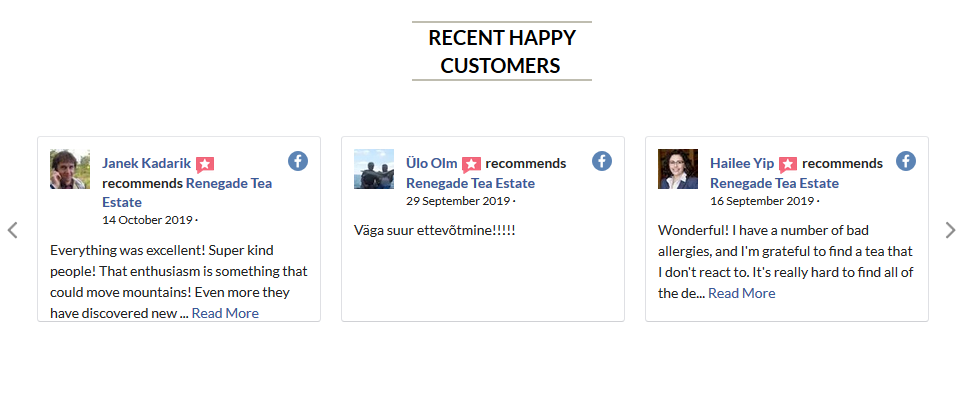 Facebook reviews widget on Renegade Tea Estate website
Facebook reviews widget on Renegade Tea Estate website
Do not neglect the importance of guest posts and sponsored content on platforms that relate to your business sector. It is essential to have a presence in places where customers seek competent advice. Industry trends analysis, research reports, best practices on external platforms show that you are a trusted expert in your business sector. Build your credibility as a trusted expert by being active in your business community by collaborating with others and building links.
In the middle of the funnel, you need to consider the audience’s desire to try out your product. So if possible, include free consultations, samples, and trials. Be sure to have customer testimonials, product datasheets, and FAQs easily visible on your page.
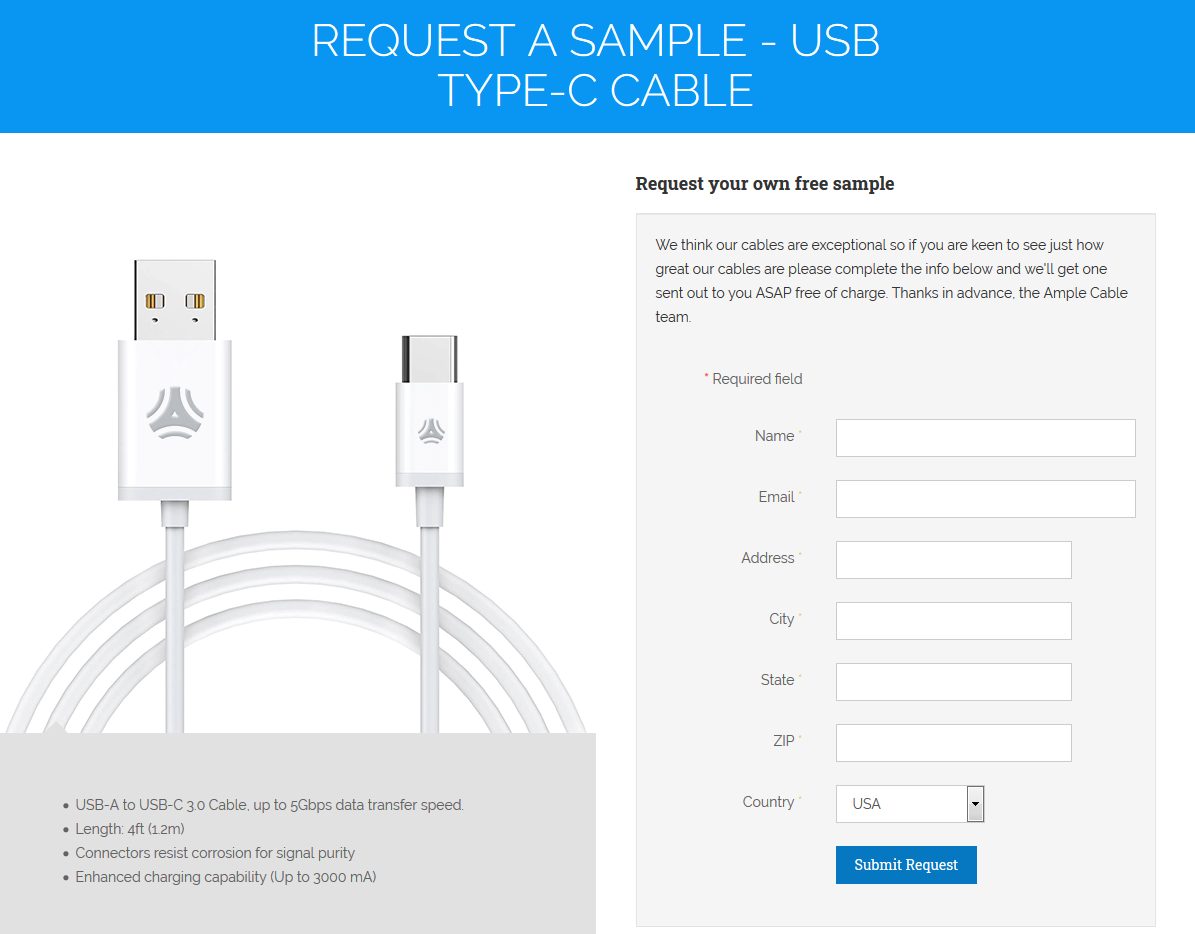 Free cable sample request form by Ample Cable
Free cable sample request form by Ample Cable
At this sales funnel stage, it is high time to involve email marketing:
- Score your leads. Identify potential customers with your sales and marketing information. This can be demographic characteristics, interaction history, website behavior, email and social engagement. Choose metrics that show a willingness to buy.
- Build segments. Divide your most responsive audience into groups according to their interests, location, or other relevant criteria.
- Nurture leads. Send meaningful information to each segment. See below an example of an email from SM Contact. It is sent to subscribers who frequently visited website sections dedicated to pin insertion technology.
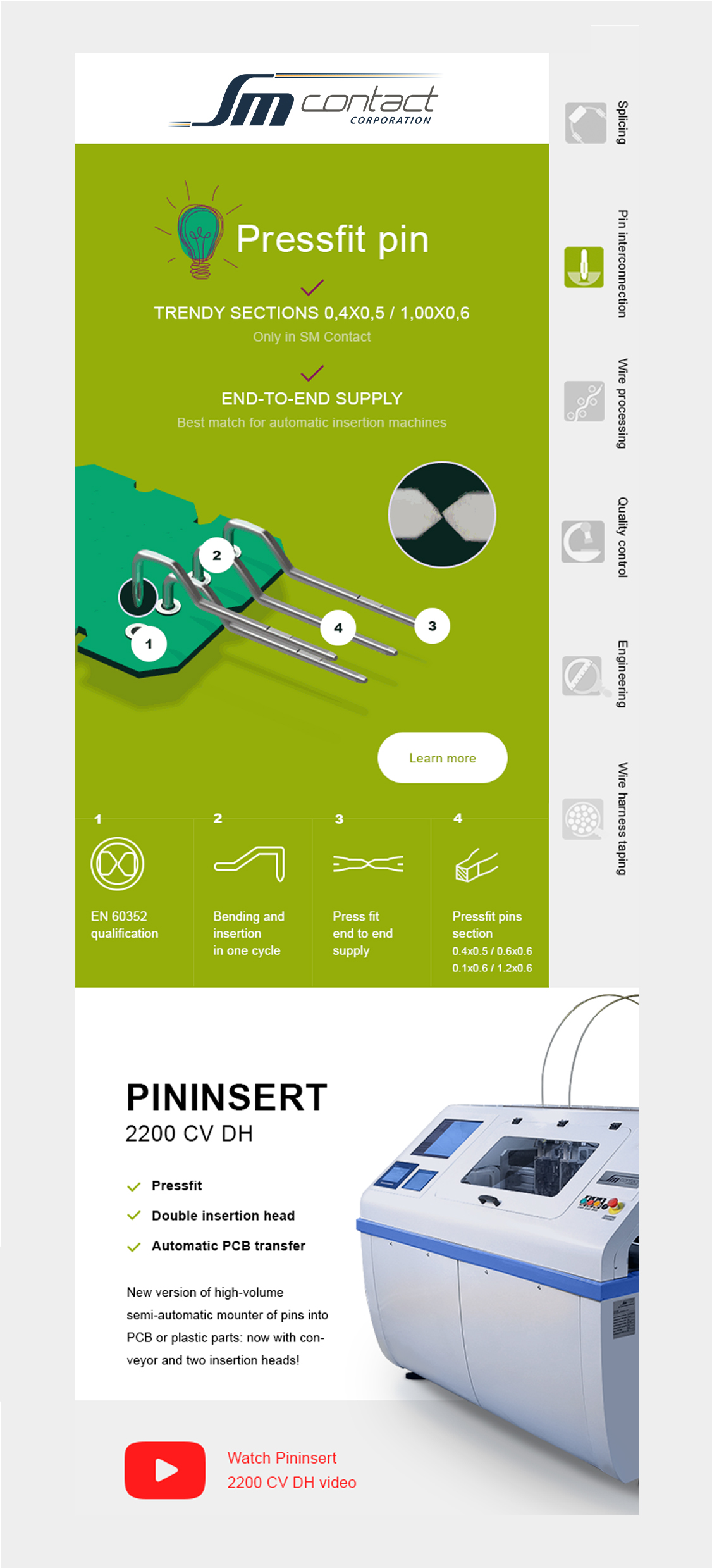 Email campaign by SM Contact for prospects interested in pin insertion technology
Email campaign by SM Contact for prospects interested in pin insertion technology
Sales Funnel Stage 4: Action
User role: buyer
Goals: lead satisfaction
Medium: email, website, product landing pages
Tools: individual proposals, contact and order forms, online shopping system, CRM integration
At the last stage of the sales funnel, you have a narrow audience that is likely to make a purchase. It is time to seal the deal.
First of all, you need a simple and direct purchase process on the website: a clear pricing page, visible order buttons, forms, a convenient shopping cart, and an easy payment system.
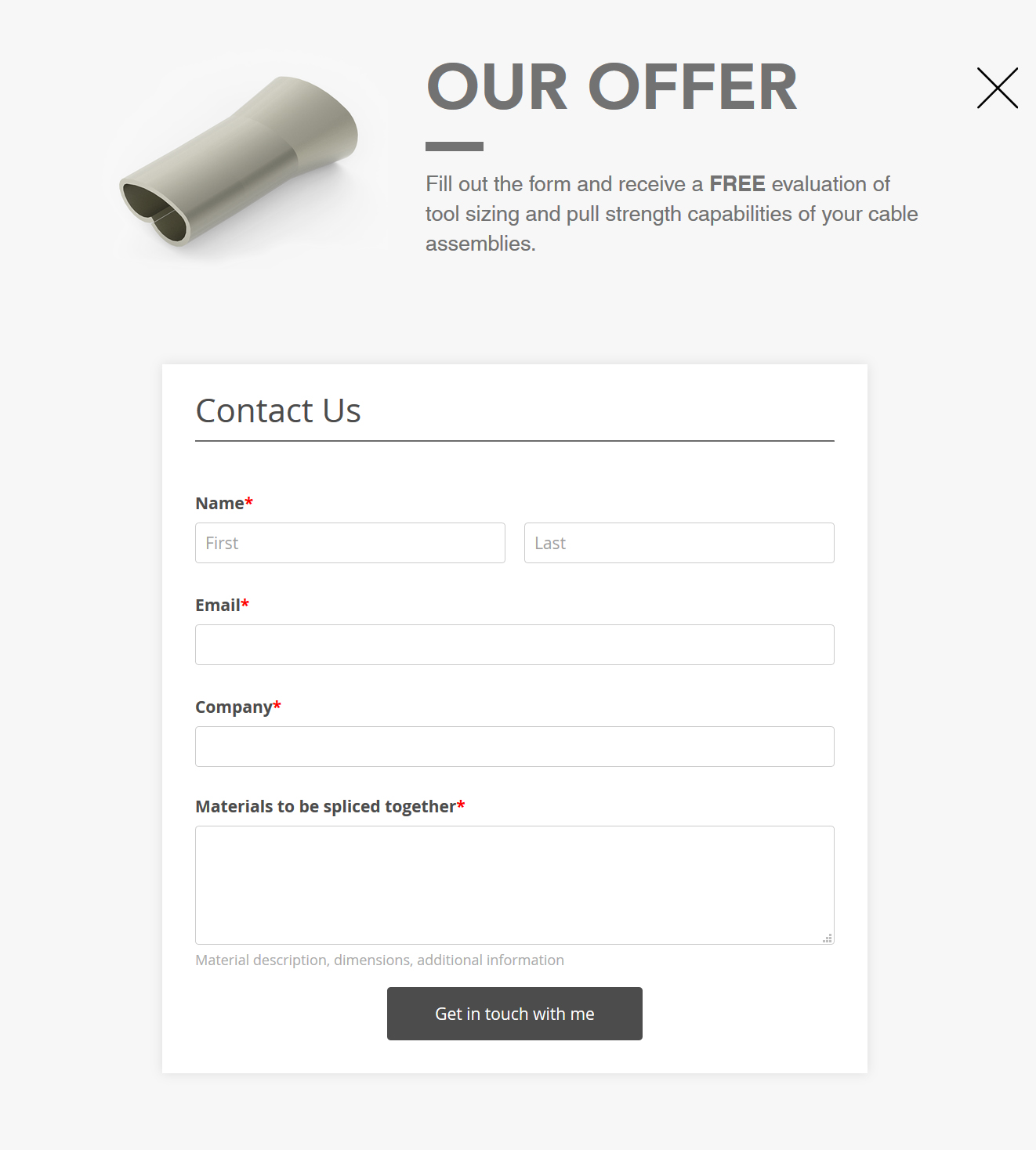 Scroll pop-up by Autosplice proposes a demo service to the most involved users
Scroll pop-up by Autosplice proposes a demo service to the most involved users
Pay attention to the cases of cart abandonment.
According to Statista, almost 70% of users worldwide abandoned their online shopping carts in 2019. The reasons that users abandon their cart varies, common issues are complicated checkout, website crashes, and undesirable delivery terms. Sometimes users just continue searching for a product from your competitors and forget about their cart. That is why eCommerce brands strongly chase after customers who haven’t checked out. For instance, they may set up an email series that starts an hour after the cart has been abandoned. The prospect receives a reminder, an offer on similar products, or discounts.
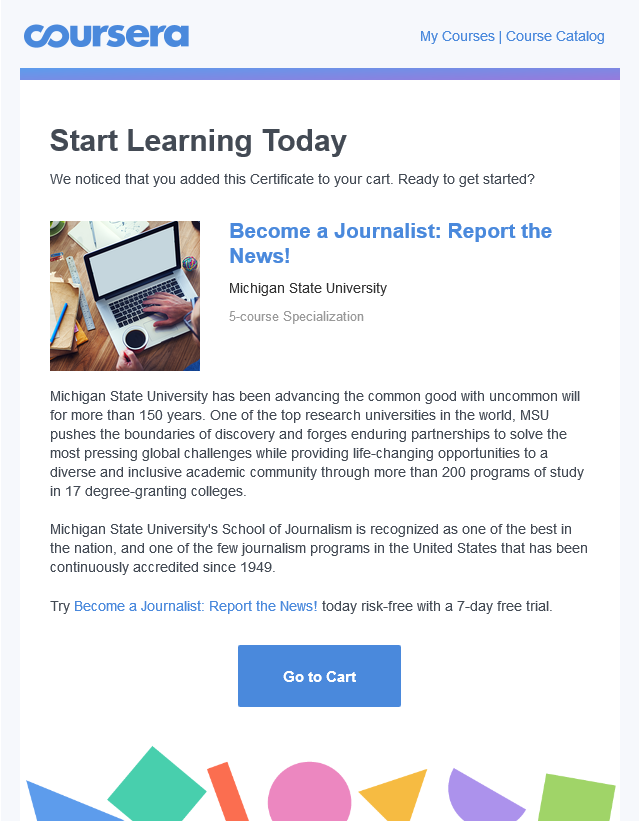 Abandoned cart email by Coursera
Abandoned cart email by Coursera
Customers can get lost even after being in personal contact with a manager: they may take a break to think it over and never return. This is exactly the moment to act: ask customers about any doubts or questions they have, make an appointment, propose further actions and help from your side. In one word, get in touch and be helpful!
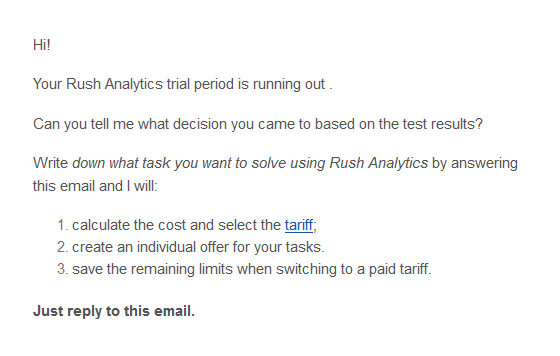 Post-trial reminder by Rush Analytics
Post-trial reminder by Rush Analytics
Sales Funnel Stage 5: Satisfaction
User role: brand advocate
Goals: build customer loyalty
Medium: email, social media, website, remarketing
Tools: feedback forms, content marketing, segmented emails
A dedicated company does kick back after completing a sale. After a customer makes a purchase it’s time to continue building a relationship with the customer. Satisfied customers are often return customers, and with luck, they will bring you new leads.
Make sure that after a purchase users have a clear way to leave feedback. Give them the option to post about their experience on their social media or your website, and to tag the company’s official social media accounts. For example, you can ask for feedback through a CTA in the personal account on your website or in your transactional emails.
Take a look at the pop-up series with a website satisfaction survey below that is shown to customers logged into their Adobe Creative Cloud Account:
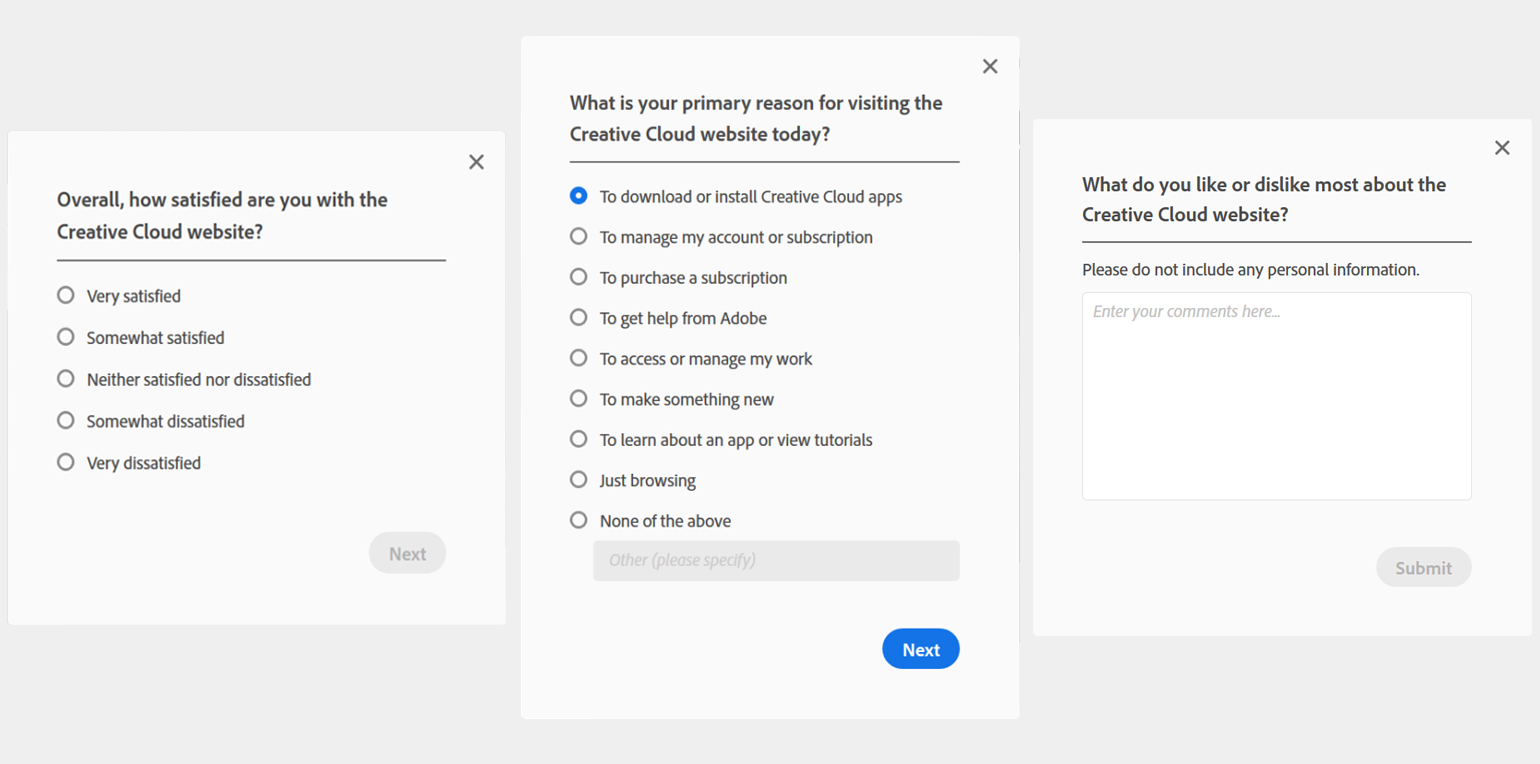 Website satisfaction survey from Adobe Creative Cloud
Website satisfaction survey from Adobe Creative Cloud
But stay alert! Receiving feedback does not mean that there is no need to care about the customer anymore. There are various further customer retention strategies that involve regular communications via email campaigns and social media.
Sending emails regularly keeps customers engaged by providing helpful tips on using your product, reminding them about maintenance and upgrades, reward balance notifications, etc. To improve its efficiency, you can segment email campaigns by customers’ interests, recent purchases, or other significant parameters.
Besides, use every opportunity to invite customers to join you on social networks. This is a way to become part of their everyday life. The more they like, comment, and share your posts, the more their emotional connection with your brand grows. In addition to product and industry-focused posts, you can run contests, publicly recognize the most engaged members, and show your company’s behind-the-scenes life.
How to evaluate the sales funnel efficiency?
Each stage of the AIDAS model corresponds to a key performance indicator (KPIs), measurable values to estimate efficiency. Include the following markers to your sales funnel template:
Awareness — Reach
At the top of the funnel, you need to reach as many qualified contacts as possible and bring them to your website. Pay attention to your reach, views, CPM (cost per mille), CPV (cost per view).
If do not reach your goal, check your targeting and visuals. Make sure that you are targeting the correct audience, using the best keywords, testing different channels and content, and engaging influencers.
To ensure marketing efficiency in the Interest stage, it is necessary to monitor users’ behavior on your website and social media pages: visits, bounce rates, users’ flow, engagement (likes, comments, shares).
Then, find bottlenecks and optimize them. For example, high bounce rates can mean a mismatch between your advertising expectations and landing page content. Try to imagine a list of questions that visitors may have when they visit your website. Do they get the answers? Are your unique sales offers clear and attractive enough?
Desire — Mentions and engagement
Being interested in your product, the audience starts to monitor various proposals and compare yours to your competitors. That’s why you should consider such KPIs as quantity, shares, tone, and passion.
You also need to track the performance of your own platforms. The primary aspects to keep in mind are page depth, average time on page, and CTA engagement. For example, if you don’t get interested users and visits to your product page are short, either the site is difficult to find or the offer itself does not look attractive.
To move visitors to the next sales funnel stages, you need to describe customer benefits in the best way possible. Vary emotional and rational arguments depending on the audience profile to show the diverse benefits of your product.
Action — Purchases
Everything is simple here: the main KPI is the cost per acquisition (CPA). Acquisition may be a purchase, registration, or inquiry, depending on your business model.
Low rates of completed purchases may indicate a difficult purchase process or registration system, communication problems with your sales team or, in the worst case, a problem with the product itself.
Satisfaction — New customers and repurchases
To estimate the results of the Satisfaction stage, you need to know if customers tell others about your company, what exactly they say, and if their suggestions attract new customers. This means tracking your company’s mention and reposts, retention and churn rates, email and social media engagement, as well as understanding where your customers are hearing about your brand.
Improve your feedback algorithm and create a loyalty program if you find your number of new customers to be low. Consumers are more likely to respond to messages that are customized to their interests, so try to nurture your brand advocates with regular quality content and personalized offers.
How to automate your sales funnel?
Let’s see an example of the sales funnel based on the AIDAS model and created with the help of an automated email series.
| Stage |
User actions |
Email activity |
| Attention |
Website visit |
Subscription form |
| Interest |
Subscription |
Welcome email
Promotional emails without obvious call to purchase |
| Desire |
Product page visits |
Targeted emails according to the pages visited with a call to purchase |
| Action |
Adding to cart |
Abandoned cart email |
|
Purchase |
Order confirmation email |
| Satisfaction |
Feedback |
Thank-you email
Promotional emails with helpful info
Cross-selling and upselling emails |
There are also more complex email funnels, for example, in B2B and event industries. For instance, the productronica Munich trade fair starts its annual email series more than a year before the event. They have separate email series for visitors and vendors, the latter also includes several branches:
- Key services that require mandatory actions from vendors: applications, vendors’ passes, marketing and technical services.
- Additional services that are optional: advertising spaces, supporting events, stand staff, multimedia equipment, etc.
Check out the example of the key services email campaign below.
Email 1. Invitation. The organizers send an invitation several times: before the application starts, on the first day, and when the early-bird rate ends. The CTA button leads to an online application form.
Early-bird application email by productronica
Email 2. Application confirmation. Form submission triggers two additional emails. First one is sent immediately and confirms that the application has been received.
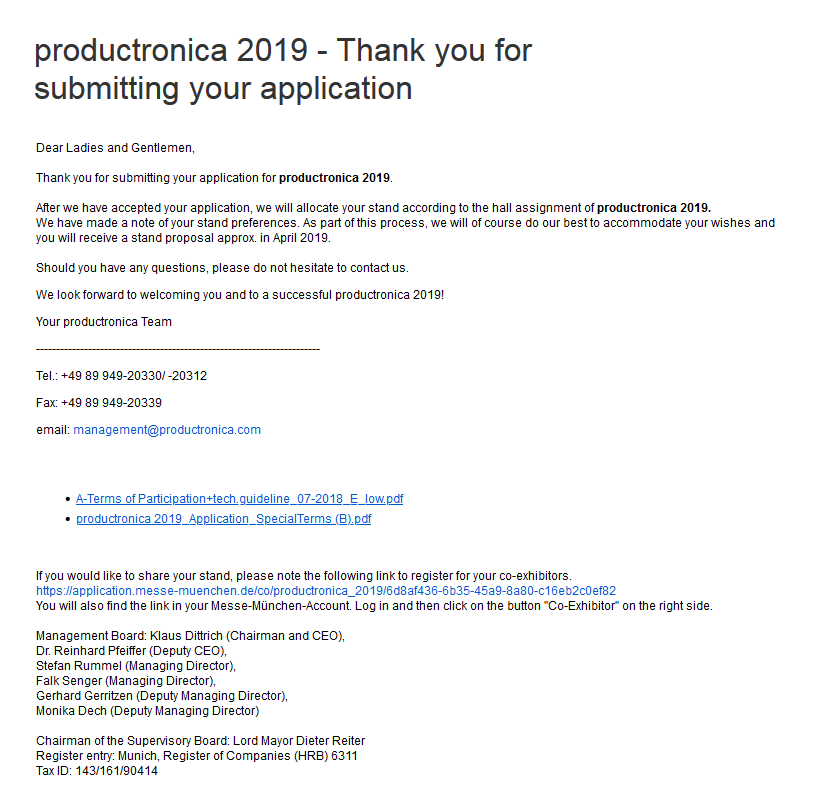 Immediate application confirmation email by productronica
Immediate application confirmation email by productronica
Second email is scheduled for after the application process is complete and informs vendors about further steps.
Date-fixed application confirmation email
Email 3. Stand location. This email sends vendors a proposal about the location of their stand, a link to the convention center’s plan, and a button to accept or decline the proposal. If the vendor refuses the proposal, the automated flow is paused and location options are discussed personally by email or by phone.
Placement proposal email by productronica
As soon as a vendor clicks the accept button, the automated flow restarts and a confirmation email arrives.
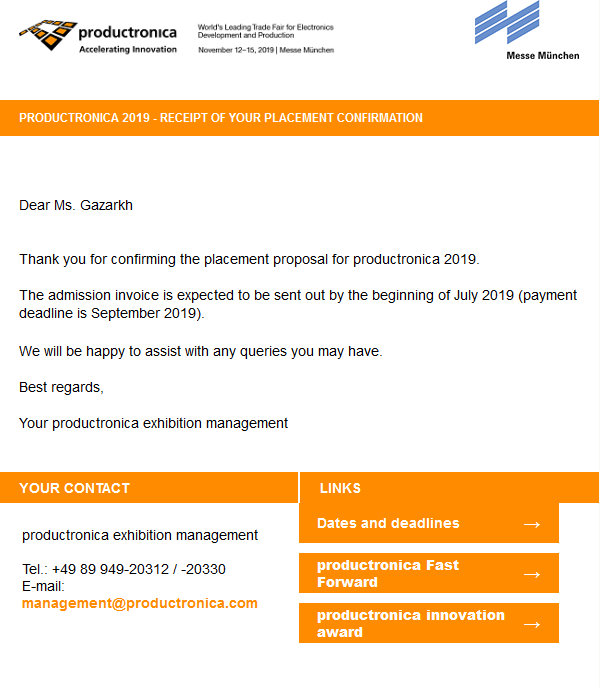 Placement confirmation email by productronica
Placement confirmation email by productronica
Email 4. Marketing and technical services. To offer vendors additional services, the team sends an authorization email that explains how to access the services store.
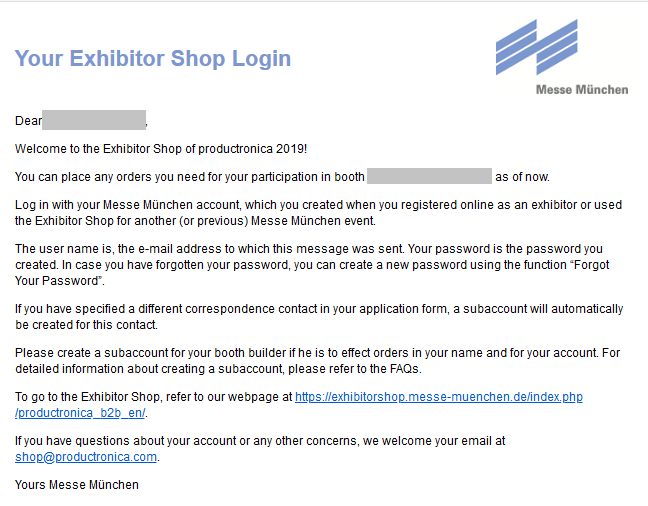 Exhibitors’ shop authorization email by productronica
Exhibitors’ shop authorization email by productronica
Then comes specific notifications for all kinds of services and their deadlines.
Marketing services offer email
Eager to start your own?
Even if you don’t have a sales funnel yet, we hope you can’t help but think about it now. So let’s get started! Imagine and work to understand your customers’ expectations and objections. Make sure to appeal to them from the search engine results to purchase, and be sure to accompany them and provide help at every step along the way.
Feel free to utilize SendPulse for marketing automation and get started with your killer sales funnel!